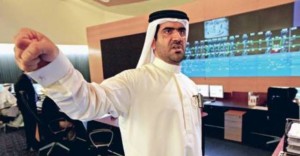By Ashfaq Ahmed, Chief Reporter www.gulfnews.com
Dubai: The operating system that runs Dubai Metro’s driver-less trains works better without human interference.

“We chose to have driverless trains for it is safer to operate them with computers as humans tend to make mistakes,” said Ramadan Abdullah, director of operations at the Rail Agency of the Dubai Roads and Transport Authority (RTA).
The system used to operate Metro trains is called Seltrac, an automatic train operation system. Seltrac can run without human help and the Metro official stressed that the system works better if no one interferes with its operations.
“Human interference is needed only to bring the system back to normal when it shuts the train service following any human error or system fault or in case of emergency,” Abdullah told Gulf News during a guided tour of the Operations Control Centre (OCC) of the Dubai Metro.
Gulf News is the first media organisation to have exclusive access to the massive control centre in Al Rashidiya. It is located in a highly secured and well protected building. However, what is amazing is the fact that 10 people, including three traffic operators, run the whole Metro system. A gigantic screen measuring 32.6 metres long and 3.6 metres high shows it all, including the power supply, real- time train movement and even the smallest of details regarding the operation.
Back-up centre
“We have a smaller back-up Operations Control Centre in Jebel Ali Depot as well, in case of any emergencies,” Abdullah said.
The OCC, equipped with high-tech equipment, is the ‘brain unit’ behind the overall operations of the Metro. It runs trains, monitors them, as well as stations, tracks and tunnels. The control room has a viewing gallery, maintenance and support room, police room and, most importantly, a crisis management room.
There are three layers of the control system. One is the bronze level which is the normal operational control at the OCC. The Silver level comes into effect when the RTA emergency response team intervenes following a disruption in Metro operation that lasts more than an hour. Top officials from the RTA and the operator Serco get involved at the Gold level when operations are halted for more than four hours. However, that is yet to happen.
The OCC has three main functions — to control the movement of trains, to monitor equipment throughout the network and communicate intelligent information. There are three sections or rows of operations and command in the OCC. The first row of seating comprises three workstations manned by three traffic operators who actually monitor the real-time operations of Metro trains.
The whole 52km Red Line track has been divided into three sections and each of the operators handles train operations in dedicated section.
The second row in the OCC is manned by support team members who monitor safety and security on the trains, stations and tunnels. They are also responsible for communications and coordinating with authorities concerned in case of any emergencies. They also control the power supply system and can shut down the whole system whenever necessary.
One chief controller on the third row controls the working of the OCC, which remains operational 24 hours a day even when train operations stop at night. The whole operational system is linked by fibre optic network connecting the OCC to tracks, stations and depots. It is a completely isolated, internal communication system and is totally safe.
Abdullah said the driverless Metro operation is very simple and safe. The trains are run by computers at the OCC, which has a timetable with trains in the system. The computers have software backups as well for extra protection.
The scheduling is done by the OCC team and they also prepare the frequency of trains and distance between trains. Once prepared, the system works automatically by computers at the OCC. The software system at the Vehicle Control Centre (VCC) continuously analyses the data and makes adjustments automatically in case of any changes, breakdowns, etc. It communicates with the Vehicle Onboard Controller — a computer installed in every train to ensure smooth operations.
Intelligent system
The system is so safe that if a train gets delayed due to technical issues, door being stuck or other such emergencies, the VCC gets the message through the system and intelligently manages the operations, distance of the train, braking if necessary as it is a self-regulatory system. Apart from the rail system which controls train traffic, the OCC also has an operation control system (OCS) which works parallel to the rail system and monitors all the other secondary systems.
It monitors the tunnel ventilation system, fire alarm system, public address systems, communication systems, lighting, air-conditioning and environmental control systems.
Each Metro station also has an OCS system which is monitored and controlled by the station master in coordination with the main OCC.
The director of Metro Operations said that the trains can also be operated manually if the need arises. Each train has an attendant trained to drive the trains. They take control of the train after getting the message to run the train manually. “The trains are normally run manually for a shorter distance to the nearest station in case of communication failure or any other emergencies,” he said.
The earthquake code was also followed during construction to protect the tracks and stations from any damage. A total of 1,900 people are currently involved in Metro operations while the entire network is monitored by 3,000 cameras. Train operations are protected by the Automatic Train Protection (ATP) system, a tested and proven technology used worldwide. If any train breaks down, the system automatically monitors the situation and stops other trains to avoid any crashes. The ATP monitors the movement of trains and, in the event of any problem, will immediately move to stop a train automatically. There is a heat deduction and fire alarm system as well. Chances of derailment are very remote. Before the start of the commercial operation, the operator runs an empty train, called the ‘sweeping train’, on the tracks every morning to ensure the track is totally safe.
Passenger safety first
The main Operations Control Centre (OCC) monitors every inch of train operations, stations, tracks, depots and tunnels with the help of more than 3,000 cameras, intelligent communication and information systems.
The OCC plays an important role in case of breakdowns and the evacuation of passengers in case of emergencies.
In case a train stops on the track due to any emergency, the first priority for the OCC is to drive it manually to the nearest station. If it is not possible, another train is brought to the scene for passengers and the third option is to allow passengers to disembark from the train on the tracks but only after the OCC cut off the power supply which is 750 volts DC.
The tracks can be elevated while walkways in tunnels help passengers walk to the nearest evacuation point. There is one evacuation point every 700 metres as per international standards. If passengers are on the elevated track, they will be able to use stairs to come down or they will be able to come out of the tunnels.
If a link is broken between the two stations in the case of any breakdown on the track, the OCC steps in to communicate for the provision of buses between the two stations to help people continue their journey.
Dubai Metro has various features which contribute to its safety and reliability. They include: Platform Screen Doors, derailment containment throughout Metro main line, continuous fencing and an Intruder Alarm System to prevent people from entering the guideway, and track maintenance vehicles.
The tracks are protected by concrete barriers and wayside obstacle detection system.
Operating system: About seltrac
The Main metro operations software called ‘Seltrac’ was provided by Thales, a Canadian company. The same operating system is used at a number of other locations including JFK airport in New York, Vancouver, Hong Kong, Kuala Lumpur and South America.
Seltrac is a transmission-based moving-block automatic train control (ATC) system, combining both automatic train protection (ATP) and automatic train operation (ATO).
The Seltrac system consists of thee main parts. Two of those are vital for running the trains, the third system provides the human interface to the system so operators can regulate the service, change scheduling and put the system back on track in case of any breakdown.
The two vital systems are the ones on the train itself and the fixed wayside system. It communicates with the onboard system called the Vehicle Onboard Controller (VOBC).
The most important part of the system is the Vital Vehicle and Track Equipment Level, which controls all movement by calculating a safety zone for every train from the data received from it, calculating a safe target point and speed and transmitting it back to the train.



















